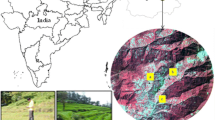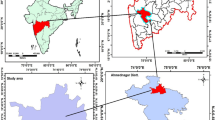Abstract
The present paper highlights the classification, change detection and future prediction of Sundarban reserve forest using multi-spectral satellite data over last 43 years (1975–2018). The remote sensing data are classified using back-propagation neural network algorithm which are healthy vegetation, unhealthy vegetation, wet land, and water bodies. The classification result demonstrates that the net forest areas were gradually declined by around 6.83% during 1975–2018, while it was not uniform over the whole period. Besides the other features also correspondingly changes. The change detection results revealed that some of the forest areas were converted into wet land and part of the wet land also flooded by water bodies due to rising sea level. To validate the forest cover classification on the images, the overall accuracy and Kappa coefficient were used. The resulting overall accuracy were 91.8%, 94.1%, 87.5%, 88.1% and 90.1% and Kappa coefficients were 0.8903, 0.9201, 0.8292, 0.8413 and 0.8680 for 1975, 1990, 2000, 2010, and 2018 respectively. Future predictions were obtained through CA-Markov Chain model which is based on the probabilistic modeling methods. The CA–Markov model shows that constant changes in forest cover. Changes in the extent of forest cover of the study area were further projected until 2034, representing that the area of net forest will be continuously reduced to 12.89%. The outcomes of this study may be offer quantitative information, which signify the base for measurement of forest ecosystem and for taking actions to reduce their degradation.












Similar content being viewed by others
References
Atkinson PM, Lewis P (2000) Geostatistical classification for remote sensing: an introduction. Comput Geosci 26(4):361–371
Atkinson PM, Tatnall ARL (1997) Introduction: neural networks in remote sensing. Int J Remote Sens 18(4):699–709
Bishop R (1993) Economic efficiency, sustainability and biodiversity. Ambio 22:69–73
Cabral P, Zamyatin A (2009) Markov Processes in Modeling Land Use and Land Cover Changes in Sintra-Cascais Portugal. Dyna, Medellin, pp 191–198
Congalton RG, Oderwald RG, Mead RA (1983) Assessing Landsat classification accuracy using discrete multivariate analysis statistical techniques. Photogramm Eng Remote Sens 49:1671–1678
Geist HJ, Lambin EF (2002) Proximate causes and underlying driving forces of tropical deforestation. Bioscience 52:143–150
Ghebrezgabher MG, Yang T, Yang X, Wang X, Khan M (2016) Extracting and analyzing forest and woodland cover change in Eritrea based on landsat data using supervised classification. The Egyptian Journal of Remote Sensing and Space Sciences 19:37–47
Ghosh A, Schmidt S, Fickert T, Nüsser M (2015) The Indian Sundarban mangrove forests: history, utilization, conservation strategies and local perception. Diversity 7(2):149–169
Giri S, Mukhopadhyay A, Hazra S, Mukherjee S, Roy D, Ghosh S, Ghosh T, Mitra D (2014) A study on abundance and distribution of mangrove species in Indian Sundarban using remote sensing technique. J Coast Conserv 18:359–367
Glenn DC, Lewin RK, Peet TTV (1992) Plant Succession: Theory and Prediction. Chapman & Hall, London
Gopal B, Chauhan M (2006) Biodiversity and its conservation in the Sundarban Mangrove Ecosystem. Aquat Sci 68(3):338–354
Heermann PD, Khazenie N (1992) Classification of multispectral remote sensing data using a back-propagation neural network. IEEE Trans Geosci Remote Sens 30(1):81–88
Houghton RA (1999) The annual net flux of carbon to the atmosphere from changes in land use 1850–1990. Tellus 51:298–313
Jonsson P, Eklundh L (2002) Seasonality Extraction by Function Fitting to Time Series of Satellite Sensor Data”. IEEE Trans Geosci Remote Sens 40(8):1824–1832
Kundu K, Halder P, Mandal JK (2020) Forest cover change analysis in Sundarban Delta using remote sensing data and GIS. In: Mandal J, Sinha D (eds) Intelligent computing paradigm: recent trends. Studies in Computational Intelligence, vol 784. Springer, Singapore. https://doi.org/10.1007/978-981-13-7334-3_7
Labs Clark (2006) IDRISI Geographic Information Systems and Remote Sensing Software. Clark Labs, Worcester
Lunetta R, Knight J, Ediriwickrema J, Lyon J, Worthy L (2006) Land-Cover Change Detection Using Multi-Temporal MODIS NDVI Data. Remote Sens Environ 105:142–154
Miller DM, Kaminsky EJ, Rana S (1995) Neural network classification of remote-sensing data. Comput Geosci 21(3):377–386
Mitsova D, Shuster W, Wang X (2011) A cellular automata model of land covers change to integrate urban growth with open space conservation. Landsc Urban Plan 99:141–153
Myers N, Mittermeier RA, Mittermeier CG et al (2000) Biodiversity hotspots for conservation priorities. Nature 403:853–858
Potter SC (1999) Terrestrial biomass and the effects of deforestation on the global carbon cycle results from a model of primary production using satellite observation. Bioscience 49:769–778
Raha A, Das S, Banerjee K, Mitra A (2012) Climate change impacts on Indian Sunderbans: a time series analysis (1924–2008). Biodivers Conserv 21(5):1289–1307
Rakesh Kumar S, Nandy RA, Kushwah SPS (2014) Forest covers dynamics analysis and prediction modeling using logistic regression model. Ecol Ind 45:444–455
Rawat JS, Kumar M (2015) Monitoring land use/cover change using remote sensing and GIS techniques: a case study of Hawalbagh block, district Almora, Uttarakhand, India. Egypt J Remote Sens Space Sci 18:77–84
Ray R, Jana TK (2017) Carbon sequestration by mangrove forest: One approach for managing carbon dioxide emission from coal-based power plant. Atmos Environ 171:149–154
Redowan M, Akter S, Islam N (2014) Analysis of forest cover change at Khadimnagar National Park, Sylhet, Bangladesh, using Landsat TM and GIS data. J For Res 25(2):393–400
Schulz JJ, Cayuela L, Echeverria C, Salas J, Jose, Marı´a Rey Benayas. (2010) Monitoring land cover change of the dryland forest landscape of Central Chile (1975–2008). Appl Geogr 30:436–447
Shukla J, Nobre C, Sellers P (1990) Amazon deforestation and climate change. Science 247:1322–1325
Strigul N, Florescu I, Welden RA, Michalczewski F (2012) Modeling of forest stand dynamics using Markov chains. Environ Model Softw 31:64–65
Sudhakar Reddy C, Jha CS, V. K. Dadhwal”, (2013) Assessment and monitoring of long-term forest cover changes in Odisha India Using Remote Sensing and GIS. Environ Monit Assess 185:4399–4415
Wolfram S (1984) Cellular automata as models of complexity. Nature 311:419–424
Yang X, Zheng X-Q, Lv LN (2012) A spatiotemporal model of land use change based on ant colony optimization, Markov chain and cellular automata. Ecol Model 233:11–19
Author information
Authors and Affiliations
Corresponding author
Additional information
Communicated by H. Babaie.
Publisher’s Note
Springer Nature remains neutral with regard to jurisdictional claims in published maps and institutional affiliations.
Rights and permissions
About this article
Cite this article
Kundu, K., Halder, P. & Mandal, J.K. Detection and Prediction of Sundarban Reserve Forest using the CA-Markov Chain Model and Remote Sensing Data. Earth Sci Inform 14, 1503–1520 (2021). https://doi.org/10.1007/s12145-021-00648-9
Received:
Accepted:
Published:
Issue Date:
DOI: https://doi.org/10.1007/s12145-021-00648-9




